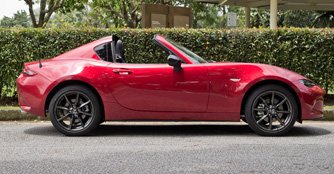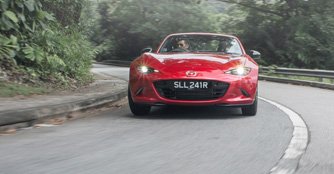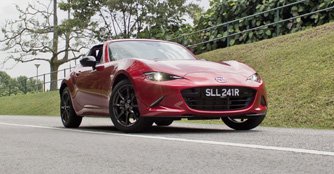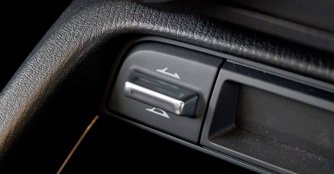Mazda MX-5 RF 2.0 (A) Review
03 Apr 2017|38,381 views
What We Like
Sublime handling
Rev-happy 2.0-litre engine
Fantastic and engaging back-to-basics driving experience
Quieter with the roof up compared to the soft-top
What We Dislike
Significant wind noise at high speeds with the roof down
We're not entirely sold on its looks
We love the Mazda MX-5, and we're not particularly shy about it. It's a lovely, back-to-basics car that offers up a uniquely different experience - a car that stands defiantly apart from most modern cars.
Now, there is a new variant available - the new Mazda MX-5 RF.

 Visually, the RF has more girth at the rear, thanks to the flying buttresses that give it it's 'Fastback' name
Visually, the RF has more girth at the rear, thanks to the flying buttresses that give it it's 'Fastback' name
What in the world is an RF?
RF stands for 'Retractable Fastback'. You can think of it as a hard-top, but that's not strictly accurate. You see, Mazda has actually produced hard-top versions of the MX-5 before. The first and second generation models were offered with a detachable hard-top, while the third generation NC model featured a Power Retractable Hard-top (PRHT). In fact, while we tend to remember the MX-5 in all its soft-top roadster glory, the PRHT model accounted for 50 percent of sales for the NC model.
So yes, this is a hard-top MX-5, but it's slightly different. The easiest way to explain this is with the roof folded down. With the previous generations, a soft-top and hard-top would look neigh indistinguishable with their roofs down. Fold the RF's roof down and the visual differences are immediately apparent.
There's slightly more car on show - the key difference is the plastic flying buttresses, with the 911 Targa probably the easiest comparison in terms of the way it looks. Is it good-looking? With the roof up, certainly. With the roof down, it's slightly more questionable. While not ugly, there are some slightly unflattering angles where it looks pudgier than we'd like.
On the go, the car is noticeably quieter with the roof up, which is good news if you're concerned with daily practicality in the MX-5. However, we did notice that with the roof down, you do get significantly more wind buffeting at high speeds compared to the soft-top.
Has the hard-top changed the car's characteristic behaviour?
This is perhaps the most important, and we reckon the only question that needs to be answered. The fear with a car like this is that the added weight would ruin its distinct character. And the simple answer is no, it has absolutely not.
Mazda say that its engineers have fiddled with some of the car's mechanical bits, including the steering, suspension and the central chassis cross member, to counteract the higher centre of gravity and increased weight. The idea is to allow the RF to have the same handling characteristics as the soft-top.
Now, there is a new variant available - the new Mazda MX-5 RF.

What in the world is an RF?
RF stands for 'Retractable Fastback'. You can think of it as a hard-top, but that's not strictly accurate. You see, Mazda has actually produced hard-top versions of the MX-5 before. The first and second generation models were offered with a detachable hard-top, while the third generation NC model featured a Power Retractable Hard-top (PRHT). In fact, while we tend to remember the MX-5 in all its soft-top roadster glory, the PRHT model accounted for 50 percent of sales for the NC model.
So yes, this is a hard-top MX-5, but it's slightly different. The easiest way to explain this is with the roof folded down. With the previous generations, a soft-top and hard-top would look neigh indistinguishable with their roofs down. Fold the RF's roof down and the visual differences are immediately apparent.
There's slightly more car on show - the key difference is the plastic flying buttresses, with the 911 Targa probably the easiest comparison in terms of the way it looks. Is it good-looking? With the roof up, certainly. With the roof down, it's slightly more questionable. While not ugly, there are some slightly unflattering angles where it looks pudgier than we'd like.
On the go, the car is noticeably quieter with the roof up, which is good news if you're concerned with daily practicality in the MX-5. However, we did notice that with the roof down, you do get significantly more wind buffeting at high speeds compared to the soft-top.
Has the hard-top changed the car's characteristic behaviour?
This is perhaps the most important, and we reckon the only question that needs to be answered. The fear with a car like this is that the added weight would ruin its distinct character. And the simple answer is no, it has absolutely not.
Mazda say that its engineers have fiddled with some of the car's mechanical bits, including the steering, suspension and the central chassis cross member, to counteract the higher centre of gravity and increased weight. The idea is to allow the RF to have the same handling characteristics as the soft-top.
It's worked, evidently. The car is still an absolute delight to drive. You get great feedback from the wheel, and the sharp and nimble steering allows you to push the car hard into corners and delight in the balance and composure of the chassis.
In our minds, the stiffened suspension makes the car feel slightly more planted in corners, but that could just be our minds playing tricks on us. Honestly, unless you drive this and the soft-top back-to-back and are hunting for differences, it'll be hard to tell them apart. And that's a fantastic accomplishment.

 The car is an absolute joy to throw into corners, with the precise steering allowing you to place the car with ease
The car is an absolute joy to throw into corners, with the precise steering allowing you to place the car with ease
Also, this 2.0-litre engine makes a resounding case of why Naturally Aspirated (NA) engines must never die. More and more car manufacturers are abandoning NA engines as turbochargers become the inevitable solution to reducing emissions, and that's a real pity.
Yes, stalwarts like Lamborghini still make their V10s and V12s, but there's a real joy in playing with a smaller capacity NA engine. It allows you to chase the red line in multiple gears, while still being in the general vicinity of the road speed limit. It's just plain ol' fun. And in many ways the MX-5 embodies just that.

 Choosing between this RF and the regular soft-top is easy because whichever you buy, it's still going to be the right one
Choosing between this RF and the regular soft-top is easy because whichever you buy, it's still going to be the right one
Which one should I buy?
Whether you choose the hard-top MX-5 RF or its soft-top twin, you're guaranteed a joyous and smile-inducing experience. And let's be real now - if you are choosing between the soft-top and the RF, you can't go wrong. You're buying an MX-5, and that's a sound decision no matter which way you look at it.
The MX-5's rightful place is on the road, nowhere else. Any car that's sitting in a garage or languishing in a showroom is an absolute injustice, because this is a car made to be driven.
In our minds, the stiffened suspension makes the car feel slightly more planted in corners, but that could just be our minds playing tricks on us. Honestly, unless you drive this and the soft-top back-to-back and are hunting for differences, it'll be hard to tell them apart. And that's a fantastic accomplishment.

Also, this 2.0-litre engine makes a resounding case of why Naturally Aspirated (NA) engines must never die. More and more car manufacturers are abandoning NA engines as turbochargers become the inevitable solution to reducing emissions, and that's a real pity.
Yes, stalwarts like Lamborghini still make their V10s and V12s, but there's a real joy in playing with a smaller capacity NA engine. It allows you to chase the red line in multiple gears, while still being in the general vicinity of the road speed limit. It's just plain ol' fun. And in many ways the MX-5 embodies just that.

Which one should I buy?
Whether you choose the hard-top MX-5 RF or its soft-top twin, you're guaranteed a joyous and smile-inducing experience. And let's be real now - if you are choosing between the soft-top and the RF, you can't go wrong. You're buying an MX-5, and that's a sound decision no matter which way you look at it.
The MX-5's rightful place is on the road, nowhere else. Any car that's sitting in a garage or languishing in a showroom is an absolute injustice, because this is a car made to be driven.
What We Like
Sublime handling
Rev-happy 2.0-litre engine
Fantastic and engaging back-to-basics driving experience
Quieter with the roof up compared to the soft-top
What We Dislike
Significant wind noise at high speeds with the roof down
We're not entirely sold on its looks
We love the Mazda MX-5, and we're not particularly shy about it. It's a lovely, back-to-basics car that offers up a uniquely different experience - a car that stands defiantly apart from most modern cars.
Now, there is a new variant available - the new Mazda MX-5 RF.
What in the world is an RF?
RF stands for 'Retractable Fastback'. You can think of it as a hard-top, but that's not strictly accurate. You see, Mazda has actually produced hard-top versions of the MX-5 before. The first and second generation models were offered with a detachable hard-top, while the third generation NC model featured a Power Retractable Hard-top (PRHT). In fact, while we tend to remember the MX-5 in all its soft-top roadster glory, the PRHT model accounted for 50 percent of sales for the NC model.
So yes, this is a hard-top MX-5, but it's slightly different. The easiest way to explain this is with the roof folded down. With the previous generations, a soft-top and hard-top would look neigh indistinguishable with their roofs down. Fold the RF's roof down and the visual differences are immediately apparent.
There's slightly more car on show - the key difference is the plastic flying buttresses, with the 911 Targa probably the easiest comparison in terms of the way it looks. Is it good-looking? With the roof up, certainly. With the roof down, it's slightly more questionable. While not ugly, there are some slightly unflattering angles where it looks pudgier than we'd like.
On the go, the car is noticeably quieter with the roof up, which is good news if you're concerned with daily practicality in the MX-5. However, we did notice that with the roof down, you do get significantly more wind buffeting at high speeds compared to the soft-top.
Has the hard-top changed the car's characteristic behaviour?
This is perhaps the most important, and we reckon the only question that needs to be answered. The fear with a car like this is that the added weight would ruin its distinct character. And the simple answer is no, it has absolutely not.
Mazda say that its engineers have fiddled with some of the car's mechanical bits, including the steering, suspension and the central chassis cross member, to counteract the higher centre of gravity and increased weight. The idea is to allow the RF to have the same handling characteristics as the soft-top.
Now, there is a new variant available - the new Mazda MX-5 RF.
What in the world is an RF?
RF stands for 'Retractable Fastback'. You can think of it as a hard-top, but that's not strictly accurate. You see, Mazda has actually produced hard-top versions of the MX-5 before. The first and second generation models were offered with a detachable hard-top, while the third generation NC model featured a Power Retractable Hard-top (PRHT). In fact, while we tend to remember the MX-5 in all its soft-top roadster glory, the PRHT model accounted for 50 percent of sales for the NC model.
So yes, this is a hard-top MX-5, but it's slightly different. The easiest way to explain this is with the roof folded down. With the previous generations, a soft-top and hard-top would look neigh indistinguishable with their roofs down. Fold the RF's roof down and the visual differences are immediately apparent.
There's slightly more car on show - the key difference is the plastic flying buttresses, with the 911 Targa probably the easiest comparison in terms of the way it looks. Is it good-looking? With the roof up, certainly. With the roof down, it's slightly more questionable. While not ugly, there are some slightly unflattering angles where it looks pudgier than we'd like.
On the go, the car is noticeably quieter with the roof up, which is good news if you're concerned with daily practicality in the MX-5. However, we did notice that with the roof down, you do get significantly more wind buffeting at high speeds compared to the soft-top.
Has the hard-top changed the car's characteristic behaviour?
This is perhaps the most important, and we reckon the only question that needs to be answered. The fear with a car like this is that the added weight would ruin its distinct character. And the simple answer is no, it has absolutely not.
Mazda say that its engineers have fiddled with some of the car's mechanical bits, including the steering, suspension and the central chassis cross member, to counteract the higher centre of gravity and increased weight. The idea is to allow the RF to have the same handling characteristics as the soft-top.
It's worked, evidently. The car is still an absolute delight to drive. You get great feedback from the wheel, and the sharp and nimble steering allows you to push the car hard into corners and delight in the balance and composure of the chassis.
In our minds, the stiffened suspension makes the car feel slightly more planted in corners, but that could just be our minds playing tricks on us. Honestly, unless you drive this and the soft-top back-to-back and are hunting for differences, it'll be hard to tell them apart. And that's a fantastic accomplishment.
Also, this 2.0-litre engine makes a resounding case of why Naturally Aspirated (NA) engines must never die. More and more car manufacturers are abandoning NA engines as turbochargers become the inevitable solution to reducing emissions, and that's a real pity.
Yes, stalwarts like Lamborghini still make their V10s and V12s, but there's a real joy in playing with a smaller capacity NA engine. It allows you to chase the red line in multiple gears, while still being in the general vicinity of the road speed limit. It's just plain ol' fun. And in many ways the MX-5 embodies just that.
Which one should I buy?
Whether you choose the hard-top MX-5 RF or its soft-top twin, you're guaranteed a joyous and smile-inducing experience. And let's be real now - if you are choosing between the soft-top and the RF, you can't go wrong. You're buying an MX-5, and that's a sound decision no matter which way you look at it.
The MX-5's rightful place is on the road, nowhere else. Any car that's sitting in a garage or languishing in a showroom is an absolute injustice, because this is a car made to be driven.
In our minds, the stiffened suspension makes the car feel slightly more planted in corners, but that could just be our minds playing tricks on us. Honestly, unless you drive this and the soft-top back-to-back and are hunting for differences, it'll be hard to tell them apart. And that's a fantastic accomplishment.
Also, this 2.0-litre engine makes a resounding case of why Naturally Aspirated (NA) engines must never die. More and more car manufacturers are abandoning NA engines as turbochargers become the inevitable solution to reducing emissions, and that's a real pity.
Yes, stalwarts like Lamborghini still make their V10s and V12s, but there's a real joy in playing with a smaller capacity NA engine. It allows you to chase the red line in multiple gears, while still being in the general vicinity of the road speed limit. It's just plain ol' fun. And in many ways the MX-5 embodies just that.
Which one should I buy?
Whether you choose the hard-top MX-5 RF or its soft-top twin, you're guaranteed a joyous and smile-inducing experience. And let's be real now - if you are choosing between the soft-top and the RF, you can't go wrong. You're buying an MX-5, and that's a sound decision no matter which way you look at it.
The MX-5's rightful place is on the road, nowhere else. Any car that's sitting in a garage or languishing in a showroom is an absolute injustice, because this is a car made to be driven.
Car Information
Mazda MX-5 RF
CAT B|Petrol|14.9km/L
Horsepower
118kW (158 bhp)
Torque
200 Nm
Acceleration
8.6sec (0-100km /hr)
Thank You For Your Subscription.












































